
About the package
While many awesome packages for network analysis exist for R, all with their own offerings and advantages, they also all have their own vocabulary, syntax, and expected formats for data inputs and analytic outputs. Many of these packages only work on some types of networks (usually one-mode, simple, directed or undirected networks) for some types of analysis; if you want to analyse a different type of network or try a different analysis, a different package is needed. And they can rely on a very different visual language (and sometimes plotting engine), which can mess up your pretty presentation or paper. This can make learning and using network analysis tools in R challenging.
By contrast, manynet offers many analytic tools that work on many (if not most) types and kinds of networks. It helps researchers make, modify, mark, measure, and identify nodes’ motifs and memberships in networks. For graph drawing see {autograph}, and for further testing and modelling capabilities see {migraph} and the other stocnet packages.
Making
Networks can come from many sources and be found in many different formats: some can be found in this or other packages, some can be created or generated using functions in this package, and others can be downloaded from the internet and imported from your file system. manynet provides tools to make networks from all these sources in any number of common formats.
Importing network data
manynet offers a number of options for importing network data found in other repositories. Besides importing and exporting to Excel edgelists, nodelists, and (bi)adjacency matrices, there are specific routines included for UCINET, Pajek, and GraphML files, e.g.:
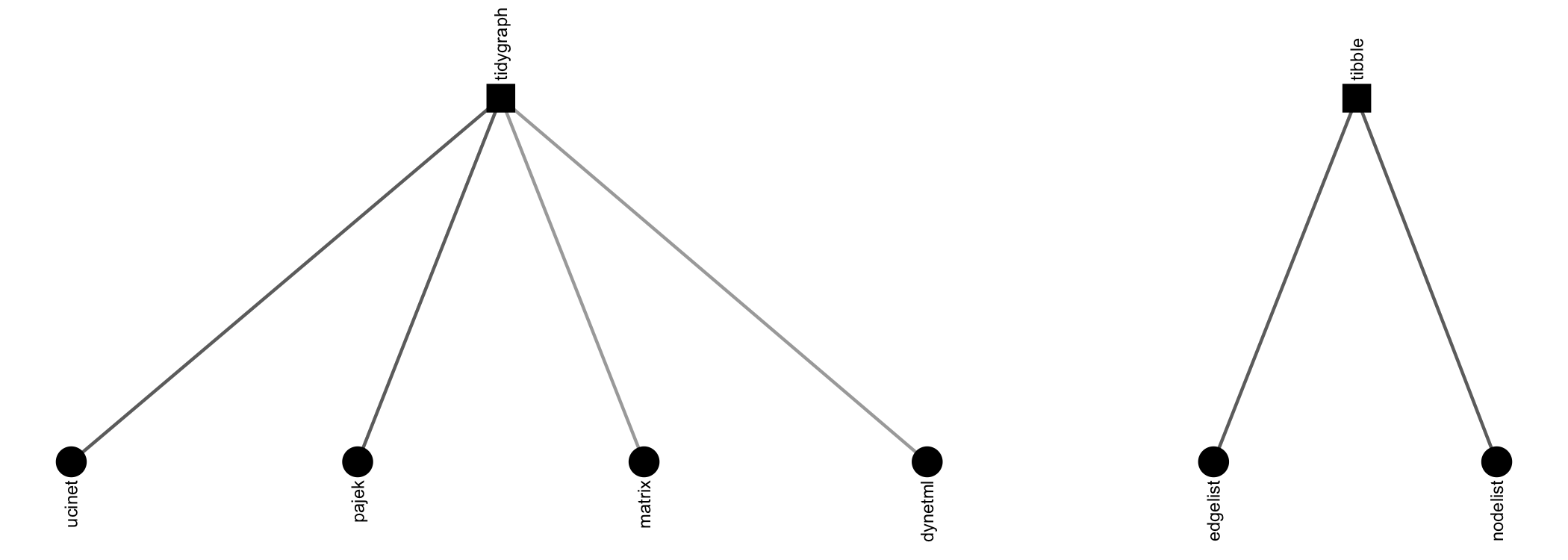
If you cannot remember the file name/path, then just run read_*() with the parentheses empty, and a file selection popup will open so that you can browse through your file system to find the file. Usually both read_*() and write_*() are offered to make sure that manynet is compatible with your larger project and analytic workflow.
Identifying network data
There may be no need to import network data though, if that network data already exists in a package in R. To facilitate testing and to contribute to an ecosystem of easily accessible network data, particularly for pedagogical purposes, we include a number of classical and instructional network datasets, all thoroughly documented and ready for analysis. Here are just a few examples, all available in manynet:
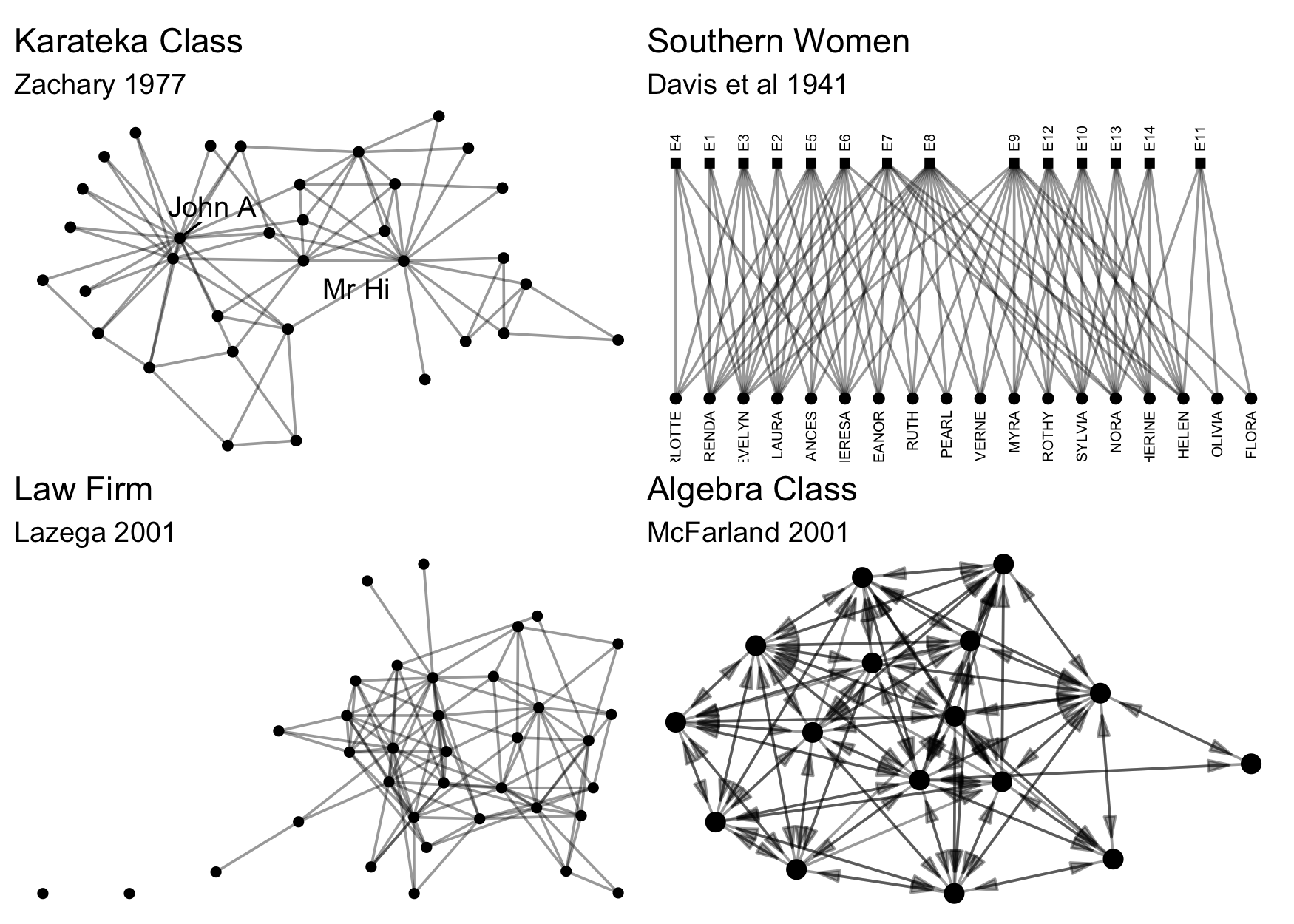
Here are some others: ison_adolescents, ison_algebra, ison_brandes, ison_dolphins, ison_hightech, ison_karateka, ison_koenigsberg, ison_laterals, ison_lawfirm, ison_marvel_relationships, ison_marvel_teams, ison_monks, ison_networkers, ison_physicians, ison_southern_women
Inventing network data
manynet includes functions for making networks algorithmically. The create_* group of functions create networks with a particular structure, and will always create the same format from the same inputs, e.g.:
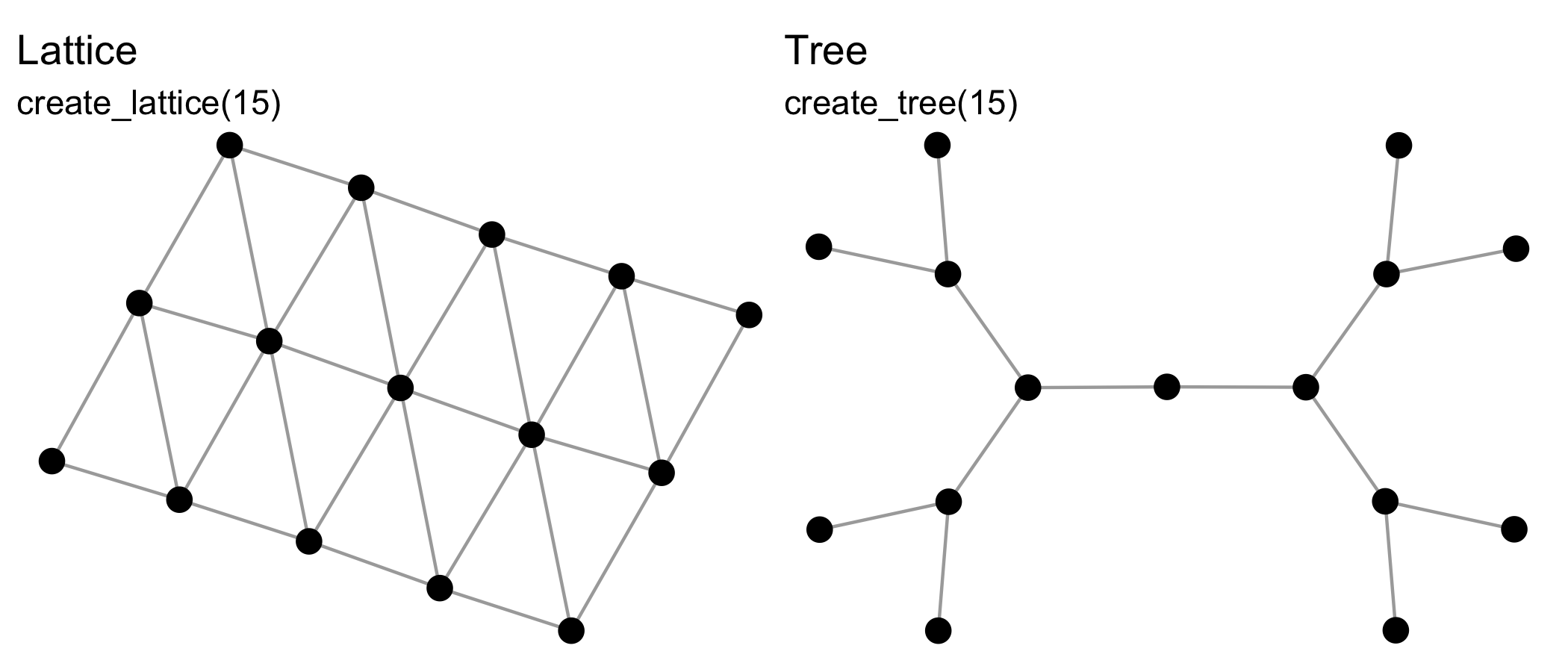
See also create_components(), create_core(), create_degree(), create_ego(), create_empty(), create_explicit(), create_filled(), create_lattice(), create_motifs(), create_ring(), create_star(), create_tree().
The generate_* group of functions generate networks from generative mechanisms that may include some random aspect, and so will return a different output each time they are run, e.g.:
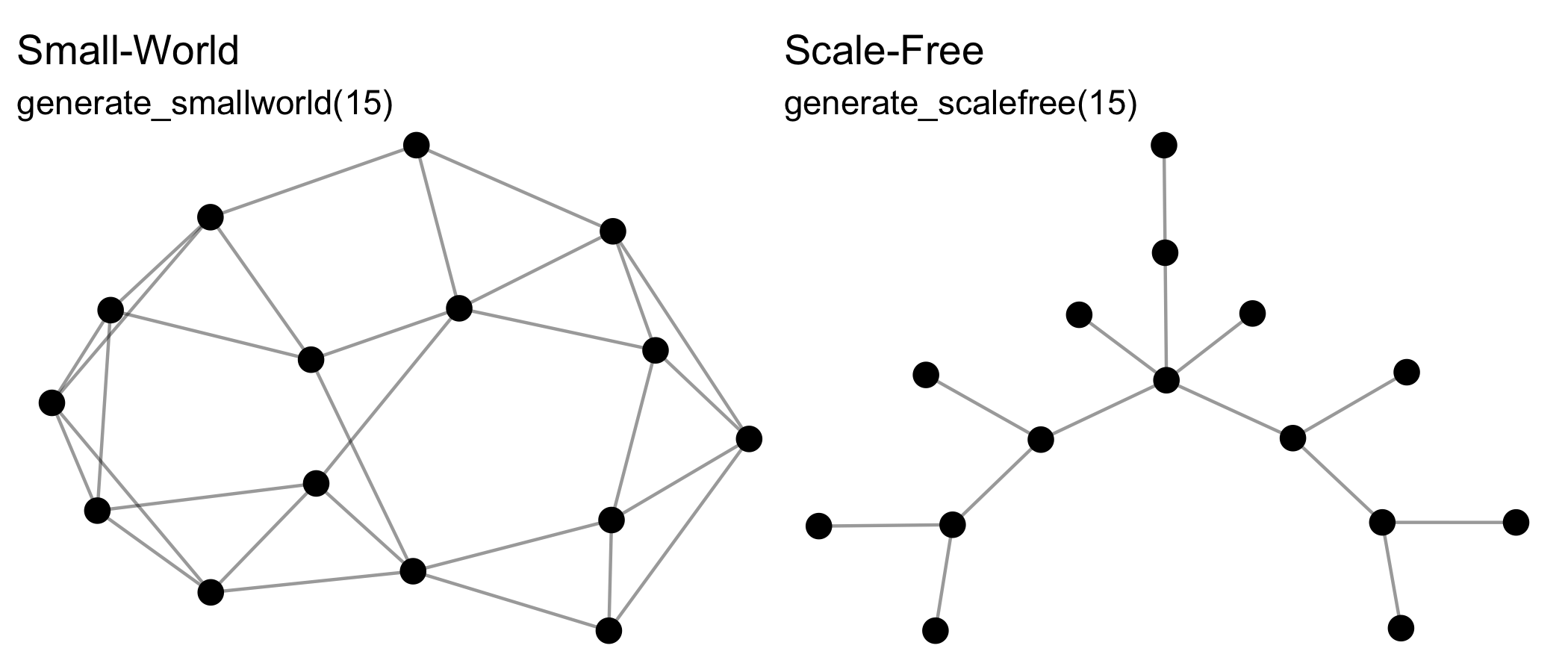
See also generate_citations(), generate_configuration(), generate_fire(), generate_islands(), generate_man(), generate_permutation(), generate_random(), generate_scalefree(), generate_smallworld(), generate_utilities().
Note that all these functions can create directed or undirected, one-mode or two-mode networks. Creating two-mode networks is as easy as passing the first argument (n) a vector of two integers instead of one. For example, while n = 15 will create a one-mode network of 10 nodes, whereas n = c(10,5) will create a two-mode network of 10 nodes in the first mode, and 5 nodes in the second mode. Some of these functions wrap existing algorithms in other packages, while others are unique offerings or add additional formats, e.g. two-mode networks.
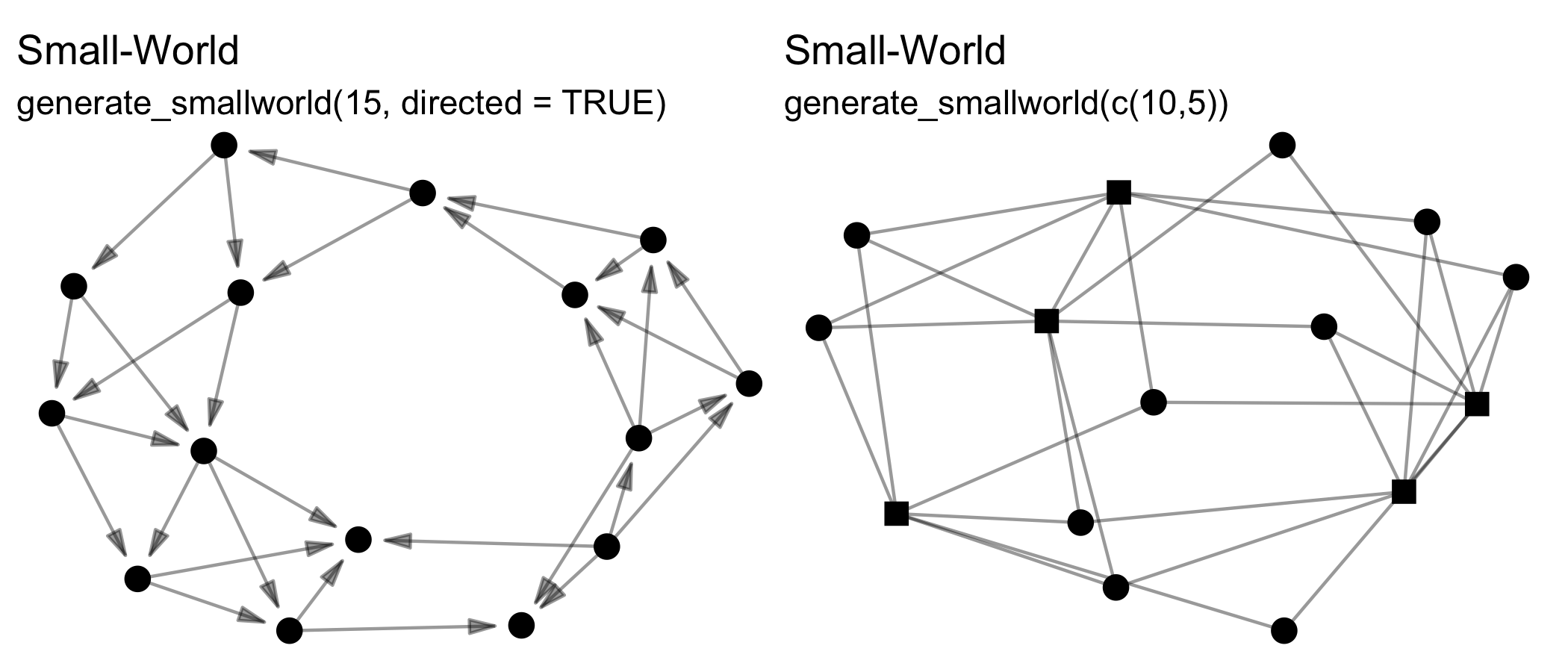
Inventing data on networks
Lastly, manynet also includes functions for simulating diffusion or learning processes over a given network:
The diffusion models include not only SI and threshold models, but also SIS, SIR, SIRS, SEIR, and SEIRS.
Modifying
Before or during analysis, you may need to modify the network you are analysing in various ways. Different packages have different syntaxes and vocabulary for such actions; manynet’s to_*() functions can be used on any class object to reformat, transform, or split networks into networks with other properties.
Translating network data
Once you have imported network data, identified network data in this or other packages in R, or invented your own, you may need to translate this data into another class for analysis. manynet’s as_*() functions can be used to coerce objects from one of many common classes into any other. Below is a directed graph showing the currently available options:
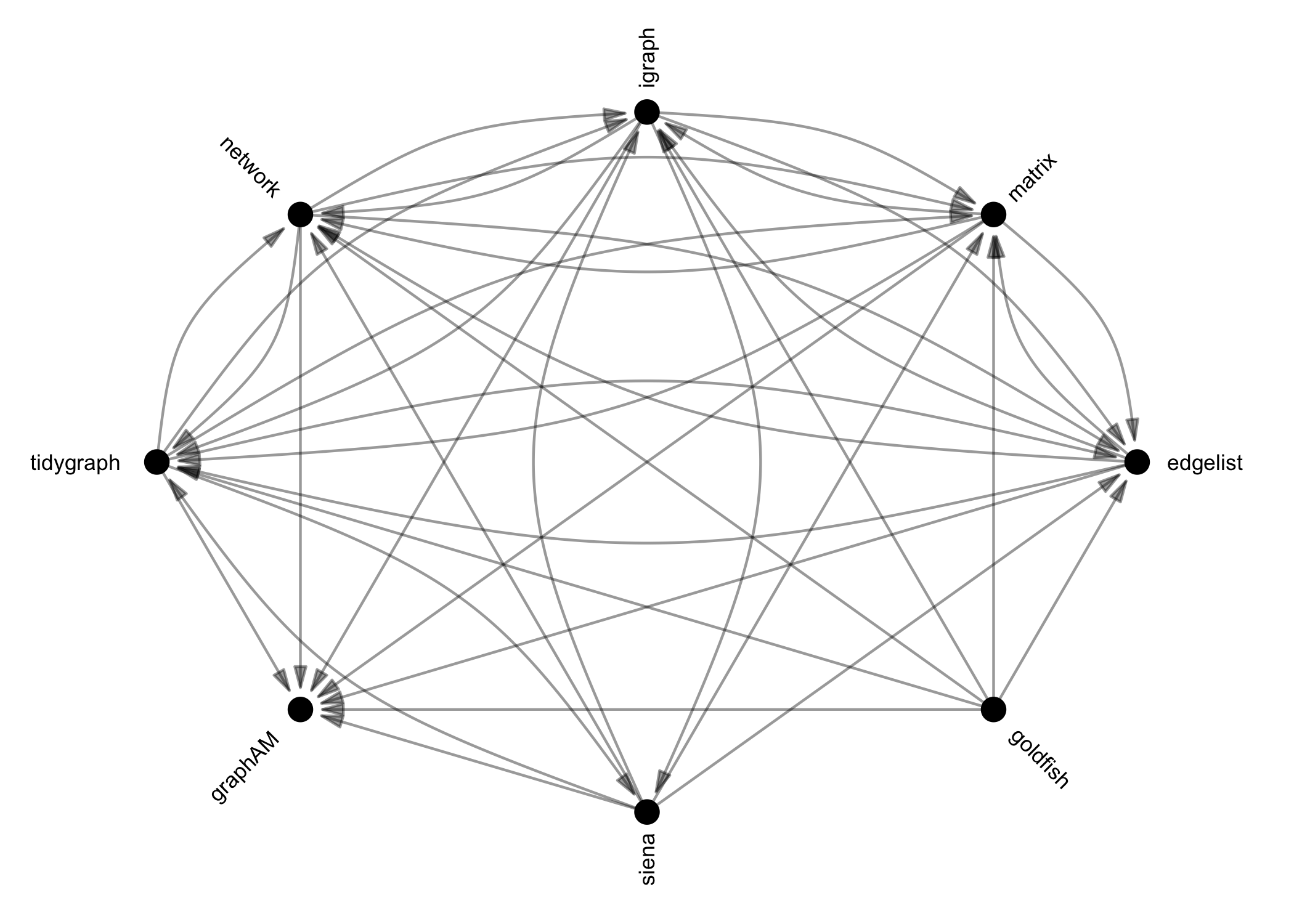
These functions are designed to be as intuitive and lossless as possible, outperforming many other class-coercion packages.
We use these functions internally in every manynet and migraph function to (1) allow them to be run on any compatible network format and (2) use the most efficient algorithm available. This makes manynet and migraph compatible with your existing workflow, whether you use base R matrices or edgelists as data frames, {igraph}, {network}, or {tidygraph}, and extensible by developments in those other packages too.
Reformatting
Reformatting means changing the format of the network, e.g. from directed to undirected via to_undirected().
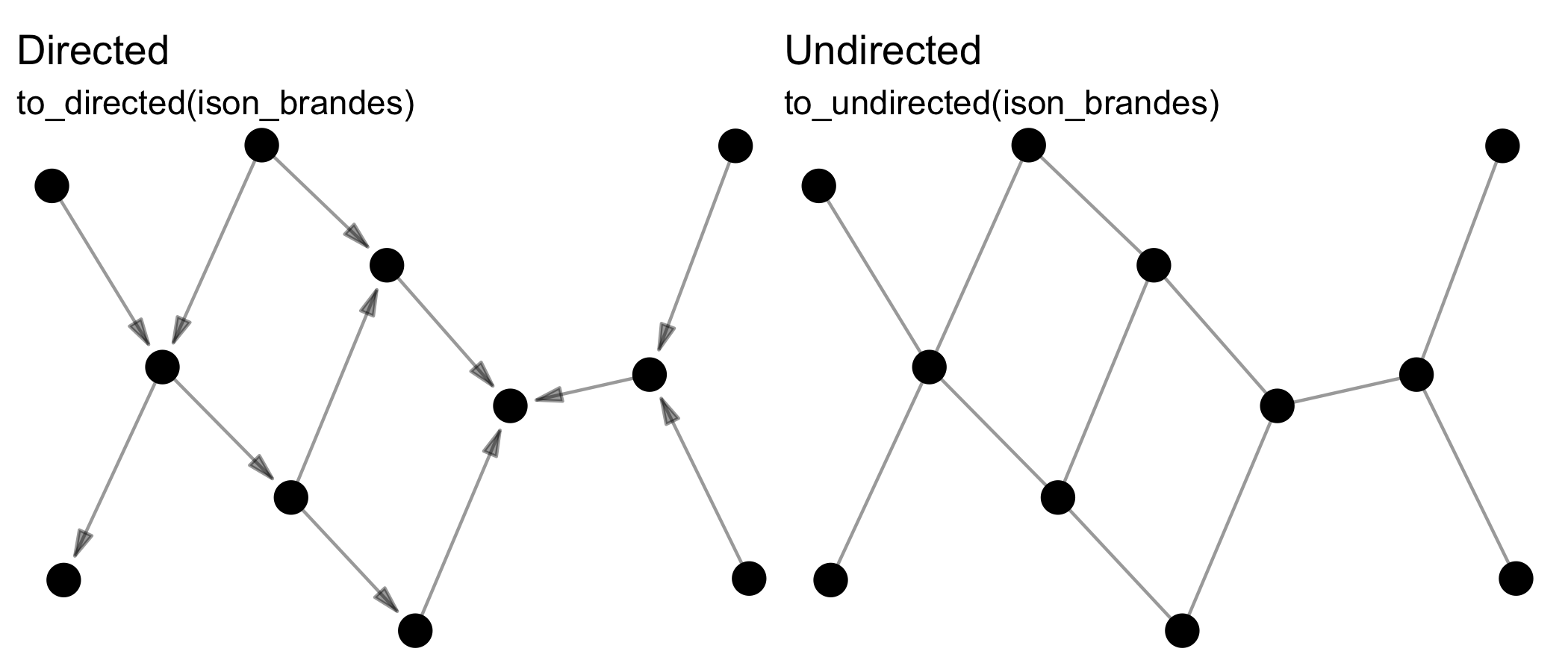
Transforming
Transforming means changing the dimensions of the network, e.g. from a two-mode network to a one-mode projection via to_mode1().
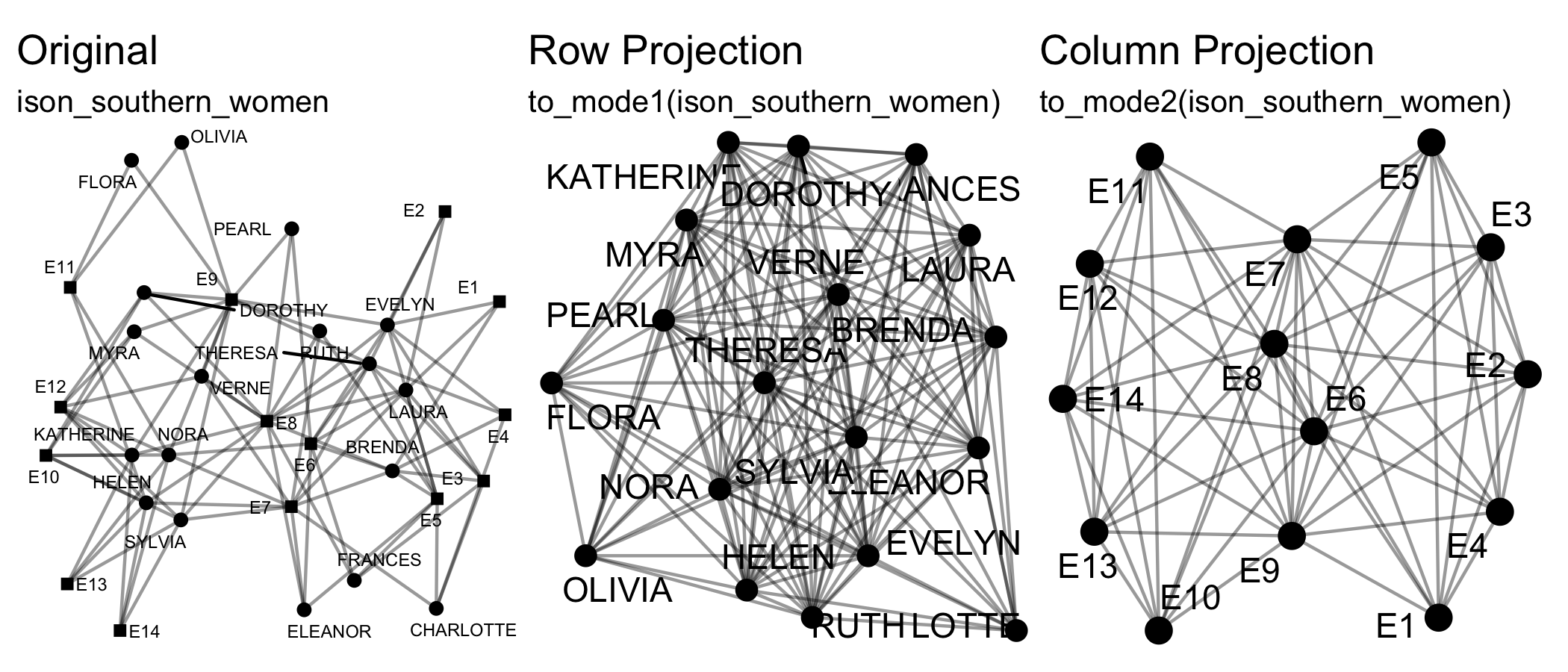
Splitting and Joining
Splitting means separating a network, e.g. from a whole network to the various ego networks via to_egos().
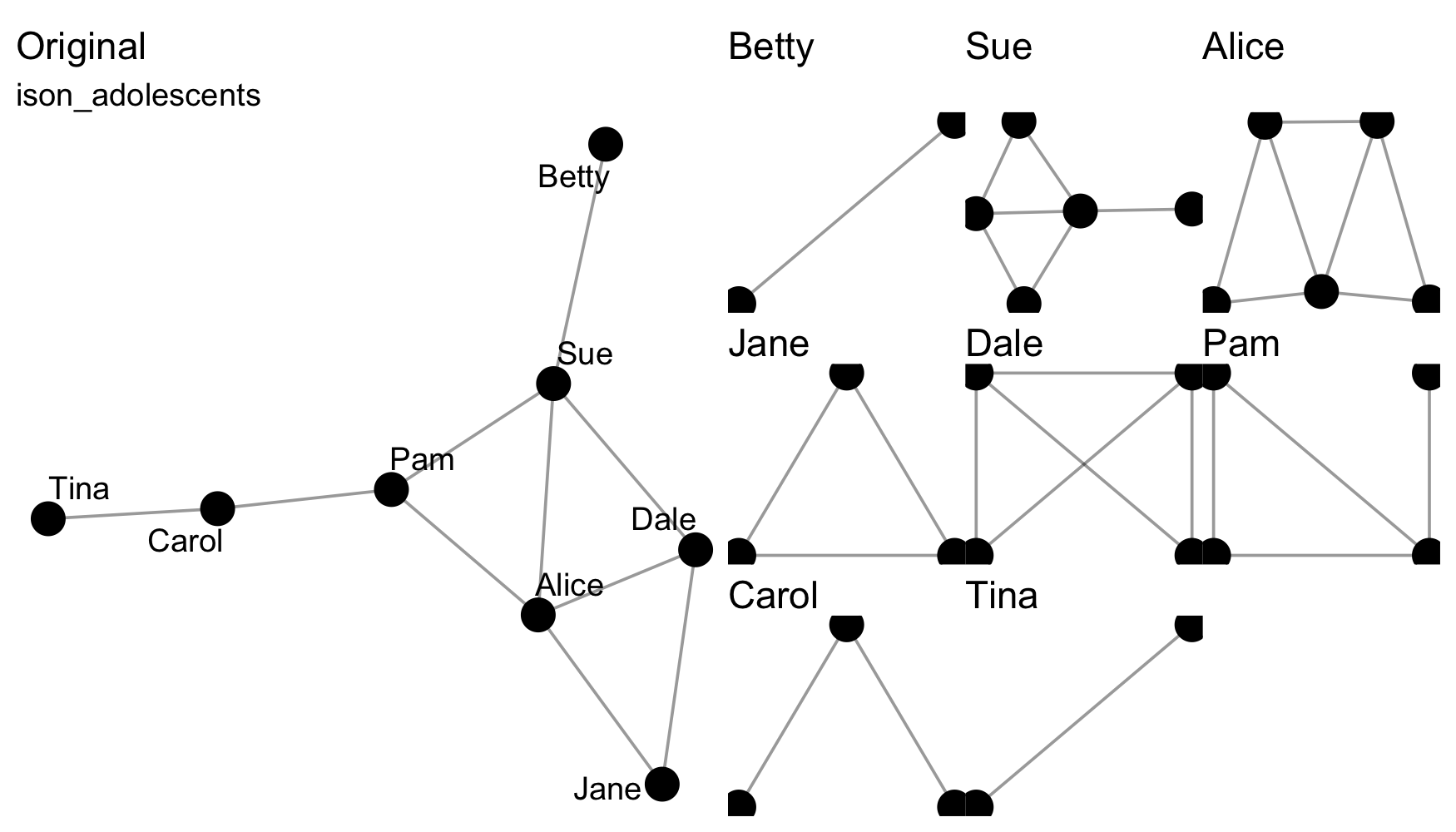
Those functions that split a network into a list of networks are distinguishable as those to_*() functions that are named in the plural. Split data can be rejoined using the from_*() family of functions.
See also to_acyclic(), to_anti(), to_blocks(), to_components(), to_correlation(), to_cosine(), to_directed(), to_dominating(), to_ego(), to_egos(), to_eulerian(), to_giant(), to_matching(), to_mentoring(), to_mode1(), to_mode2(), to_multilevel(), to_named(), to_no_isolates(), to_no_missing(), to_onemode(), to_permuted(), to_reciprocated(), to_redirected(), to_signed(), to_simplex(), to_slices(), to_subgraph(), to_subgraphs(), to_ties(), to_time(), to_tree(), to_twomode(), to_undirected(), to_uniplex(), to_unnamed(), to_unsigned(), to_unweighted(), to_waves(), to_weighted() and from_egos(), from_slices(), from_subgraphs(), from_ties(), from_waves().
Marking
manynet includes four special groups of functions, each with their own pretty print() and plot() methods: marks, measures, motifs, and memberships. Marks are logical scalars or vectors, measures are numeric, memberships categorical, and motifs result in tabular outputs.
manynet’s *is_*() functions offer fast logical tests of various properties. Whereas is_*() returns a single logical value for the network, node_is_*() returns a logical vector the length of the number of nodes in the network, and tie_is_*() returns a logical vector the length of the number of ties in the network.
-
is_acyclic(),is_aperiodic(),is_attributed(),is_changing(),is_complex(),is_connected(),is_directed(),is_dynamic(),is_edgelist(),is_eulerian(),is_graph(),is_igraph(),is_labelled(),is_list(),is_longitudinal(),is_manynet(),is_multiplex(),is_perfect_matching(),is_signed(),is_twomode(),is_uniplex(),is_weighted() -
node_is_core(),node_is_cutpoint(),node_is_exposed(),node_is_fold(),node_is_independent(),node_is_infected(),node_is_isolate(),node_is_latent(),node_is_max(),node_is_mean(),node_is_mentor(),node_is_min(),node_is_mode(),node_is_neighbor(),node_is_pendant(),node_is_random(),node_is_recovered(),node_is_universal() -
tie_is_bridge(),tie_is_cyclical(),tie_is_feedback(),tie_is_forbidden(),tie_is_imbalanced(),tie_is_loop(),tie_is_max(),tie_is_min(),tie_is_multiple(),tie_is_path(),tie_is_random(),tie_is_reciprocated(),tie_is_simmelian(),tie_is_transitive(),tie_is_triangular(),tie_is_triplet()
The *is_max() and *is_min() functions are used to identify the maximum or minimum, respectively, node or tie according to some measure (see below).
Motifs
manynet‘s *by_*() functions tabulate nodes’ frequency in various motifs. These include:
Memberships
manynet‘s *in_*() functions identify nodes’ membership in some grouping, such as a community or component. These functions always return a character vector, indicating e.g. that the first node is a member of group “A”, the second in group “B”, etc.
-
node_in_adopter(),node_in_automorphic(),node_in_betweenness(),node_in_brokering(),node_in_community(),node_in_component(),node_in_eigen(),node_in_equivalence(),node_in_fluid(),node_in_greedy(),node_in_infomap(),node_in_leiden(),node_in_louvain(),node_in_optimal(),node_in_partition(),node_in_regular(),node_in_roulette(),node_in_spinglass(),node_in_strong(),node_in_structural(),node_in_walktrap(),node_in_weak()
For example node_brokerage_census() returns the frequency of nodes’ participation in Gould-Fernandez brokerage roles for a one-mode network, and the Jasny-Lubell brokerage roles for a two-mode network.
These can be analysed alone, or used as a profile for establishing equivalence. manynet offers both HCA and CONCOR algorithms, as well as elbow, silhouette, and strict methods for k-cluster selection.

manynet also includes functions for establishing membership on other bases, such as typical community detection algorithms, as well as component and core-periphery partitioning algorithms.
Measuring
manynet also offers a large and growing smorgasbord of measures that can be used at the node, tie, and network level to measure some feature, property, or quantity of the network. Each recognises whether the network is directed or undirected, weighted or unweighted, one-mode or two-mode. All return normalized values wherever possible, though this can be overrided. Here are some examples:
-
Centrality:
node_degree(),node_closeness(),node_betweenness(), andnode_eigenvector(),net_degree(),net_closeness(),net_betweenness(), andnet_eigenvector() -
Cohesion:
net_density(),net_reciprocity(),net_transitivity(),net_equivalency(), andnet_congruency() -
Hierarchy:
net_connectedness(),net_efficiency(),net_upperbound() -
Resilience:
net_components(),net_cohesion(),net_adhesion(),net_diameter(),net_length() -
Innovation: e.g.
node_redundancy(),node_effsize(),node_efficiency(),node_constraint(),node_hierarchy() -
Diversity:
net_richness(),net_diversity(),net_heterophily(),net_assortativity(),node_richness(),node_diversity(),node_heterophily(),node_assortativity() -
Topology: e.g.
net_core(),net_factions(),net_modularity(),net_smallworld(),net_balance() -
Diffusion: e.g.
net_reproduction(),net_immunity(),node_thresholds()
There is a lot here, so we recommend you explore the list of functions to find out more.
Tutorials
This package includes tutorials to help new and experienced users learn how they can conduct social network analysis using the package. These tutorials leverage the additional package learnr (see here), but we have made it easy to use manynet or migraph tutorials right out of the box:
run_tute()
#> Checking tutorials in stocnet packages ■■■■■■■■■■■■■■■■ 50% | …
#> # A tibble: 9 × 3
#> package name title
#> <chr> <chr> <chr>
#> 1 manynet tutorial0 Intro to R
#> 2 manynet tutorial1 Data
#> 3 manynet tutorial2 Visualisation
#> 4 manynet tutorial3 Centrality
#> 5 manynet tutorial4 Cohesion and Community
#> 6 manynet tutorial5 Position and Equivalence
#> 7 manynet tutorial6 Topology and Resilience
#> 8 migraph tutorial7 Diffusion and Learning
#> 9 migraph tutorial8 Diversity and Regression
#> ℹ You can run one of these tutorials by typing e.g `run_tute('tutorial1')` or `run_tute('Data')` into the console.
# run_tute("tutorial1")Installation
Stable
The easiest way to install the latest stable version of manynet is via CRAN. Simply open the R console and enter:
install.packages('manynet')
library(manynet) will then load the package and make the data and tutorials (see below) contained within the package available.
Development
For the latest development version, for slightly earlier access to new features or for testing, you may wish to download and install the binaries from Github or install from source locally. The latest binary releases for all major OSes – Windows, Mac, and Linux – can be found here. Download the appropriate binary for your operating system, and install using an adapted version of the following commands:
- For Windows:
install.packages("~/Downloads/manynet_winOS.zip", repos = NULL) - For Mac:
install.packages("~/Downloads/manynet_macOS.tgz", repos = NULL) - For Unix:
install.packages("~/Downloads/manynet_linuxOS.tar.gz", repos = NULL)
To install from source the latest main version of manynet from Github, please install the remotes package from CRAN and then:
- For latest stable version:
remotes::install_github("stocnet/manynet") - For latest development version:
remotes::install_github("stocnet/manynet@develop")
Relationship to other packages
This package stands on the shoulders of several incredible packages.
In terms of the objects it works with, this package aims to provide an updated, more comprehensive replacement for intergraph. As such it works with objects in igraph and network formats, but also equally well with base matrices and edgelists (data frames), and formats from several other packages.
The user interface is inspired in some ways by Thomas Lin Pedersen’s excellent tidygraph package, though makes some different decisions, and uses the quickest igraph or network routines where available.
manynet has inherited most of its core functionality from its maternal package, migraph. migraph continues to offer more analytic and modelling functions that builds upon the architecture provided by manynet. For more, please check out migraph directly.
Funding details
Development on this package has been funded by the Swiss National Science Foundation (SNSF) Grant Number 188976: “Power and Networks and the Rate of Change in Institutional Complexes” (PANARCHIC).